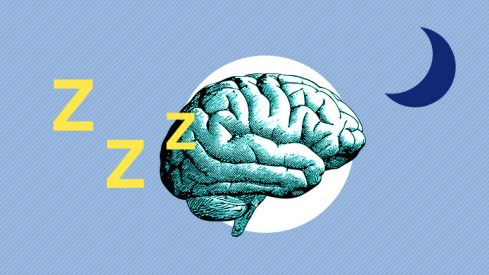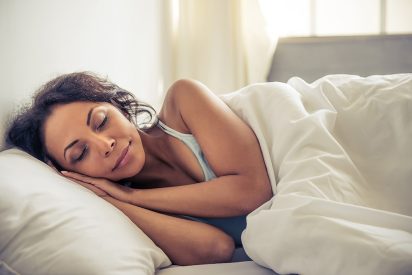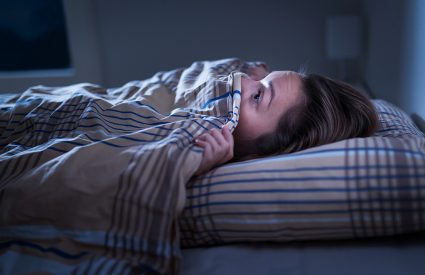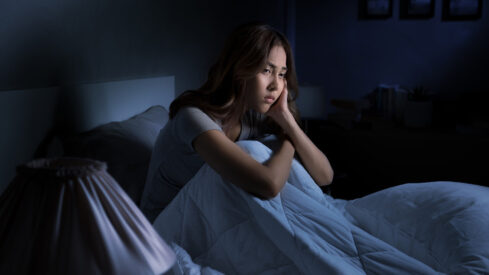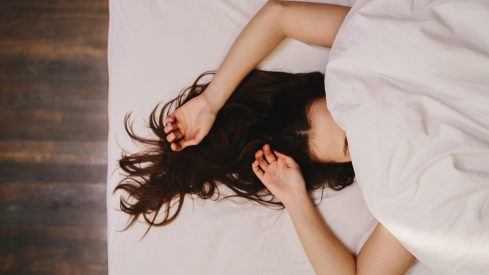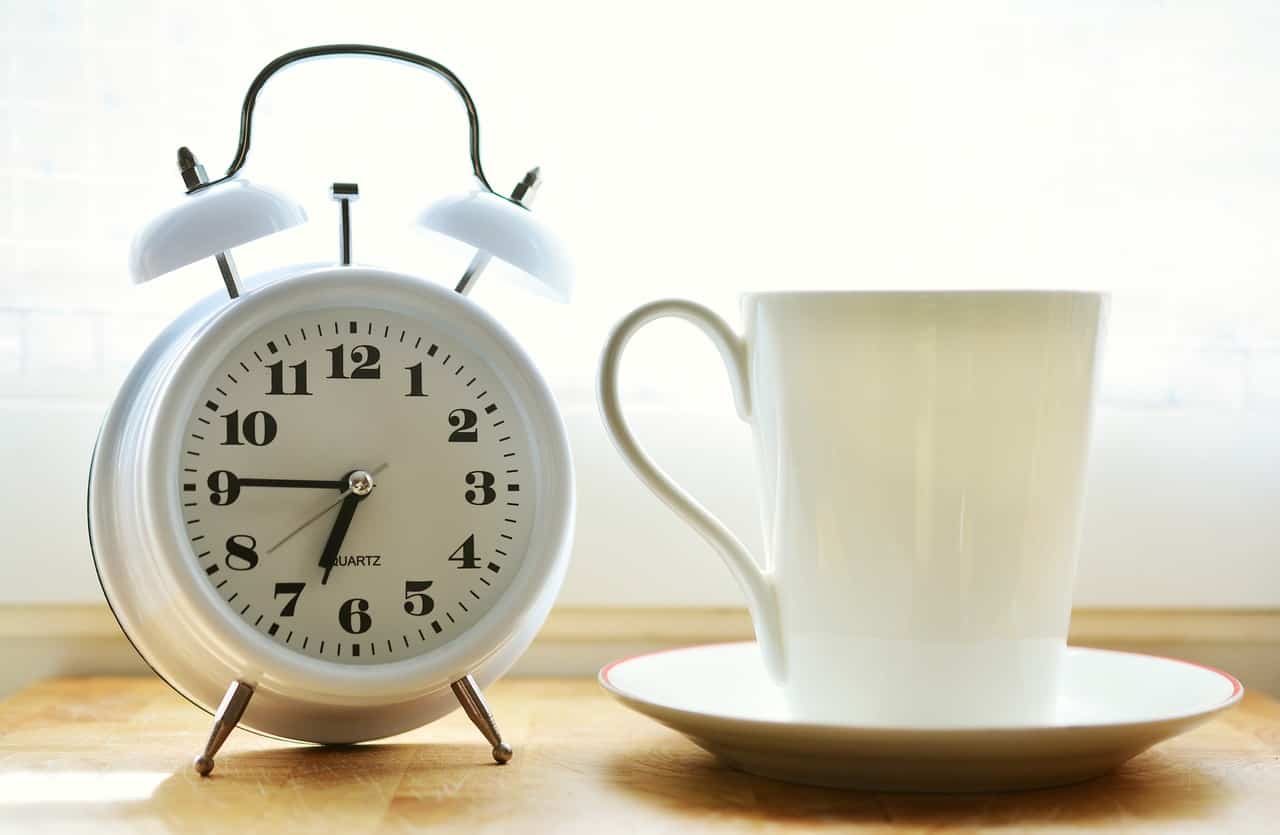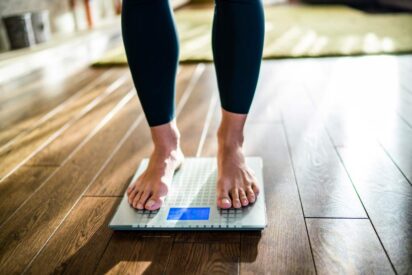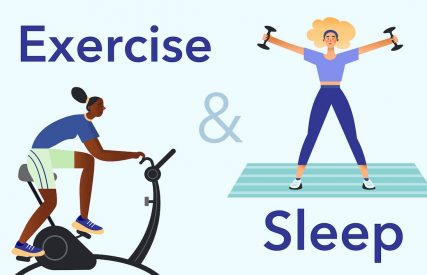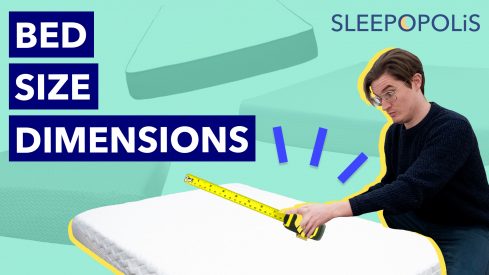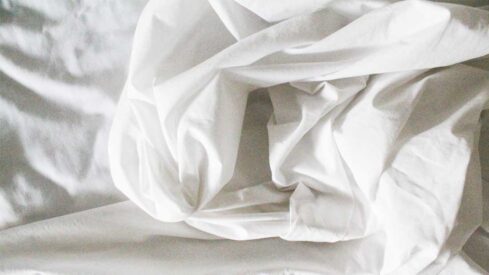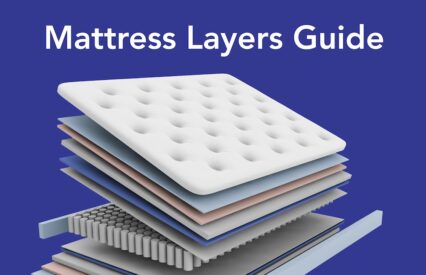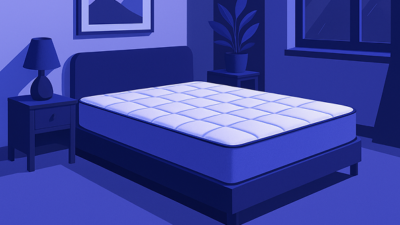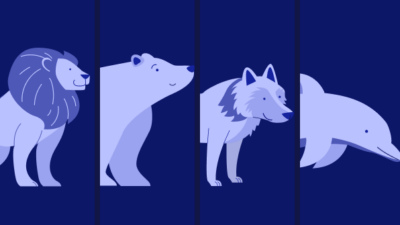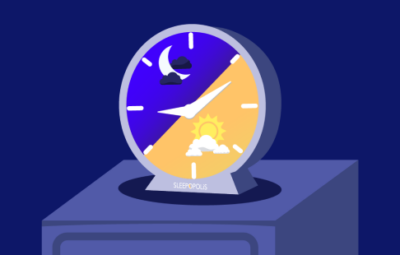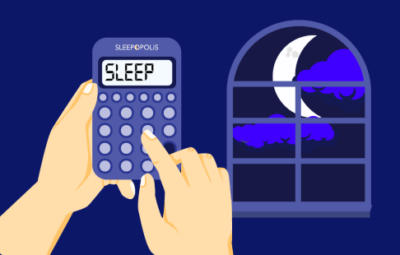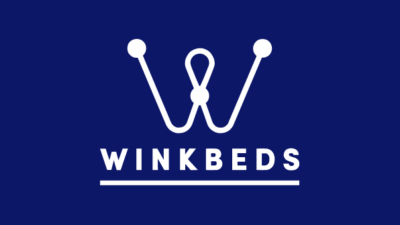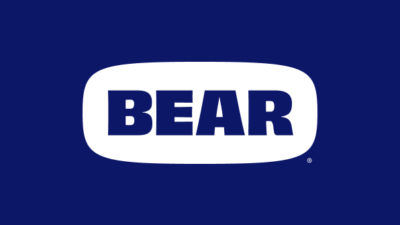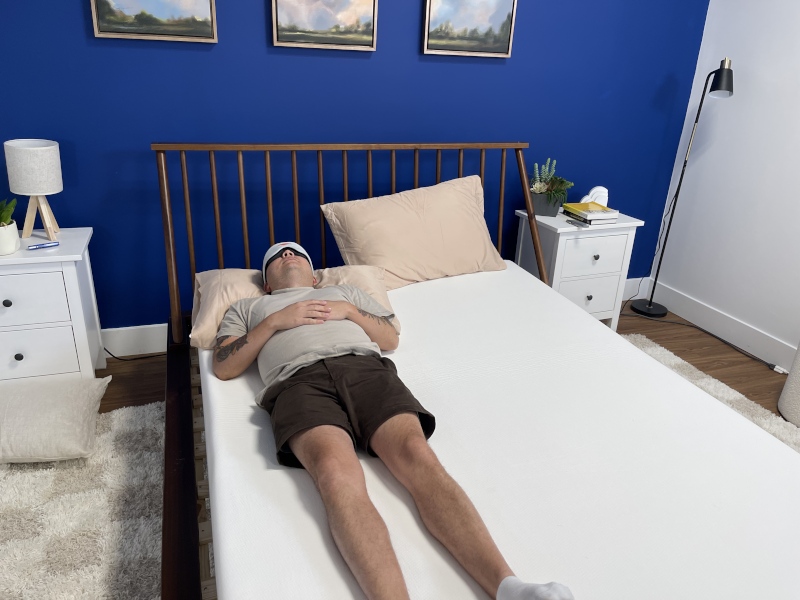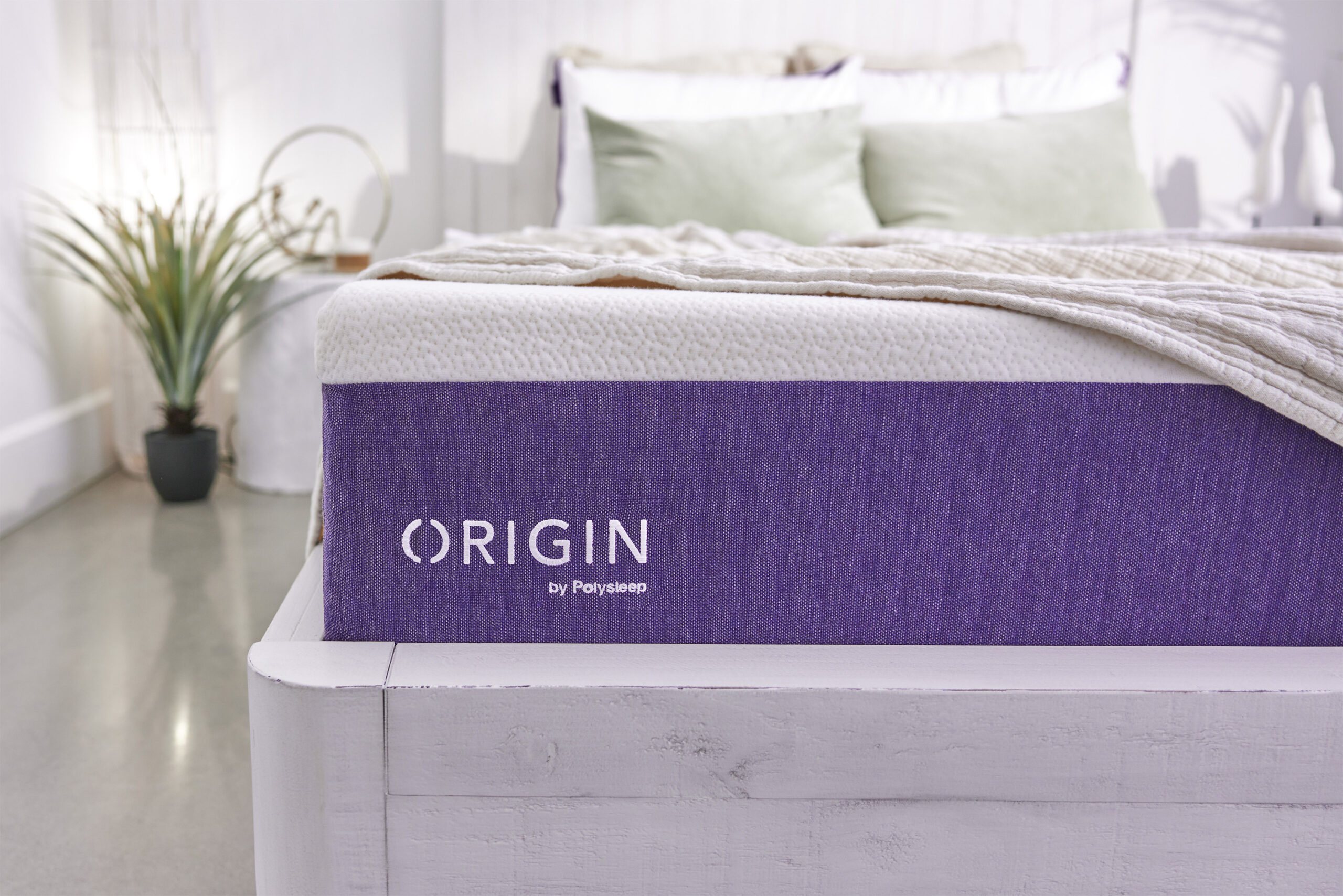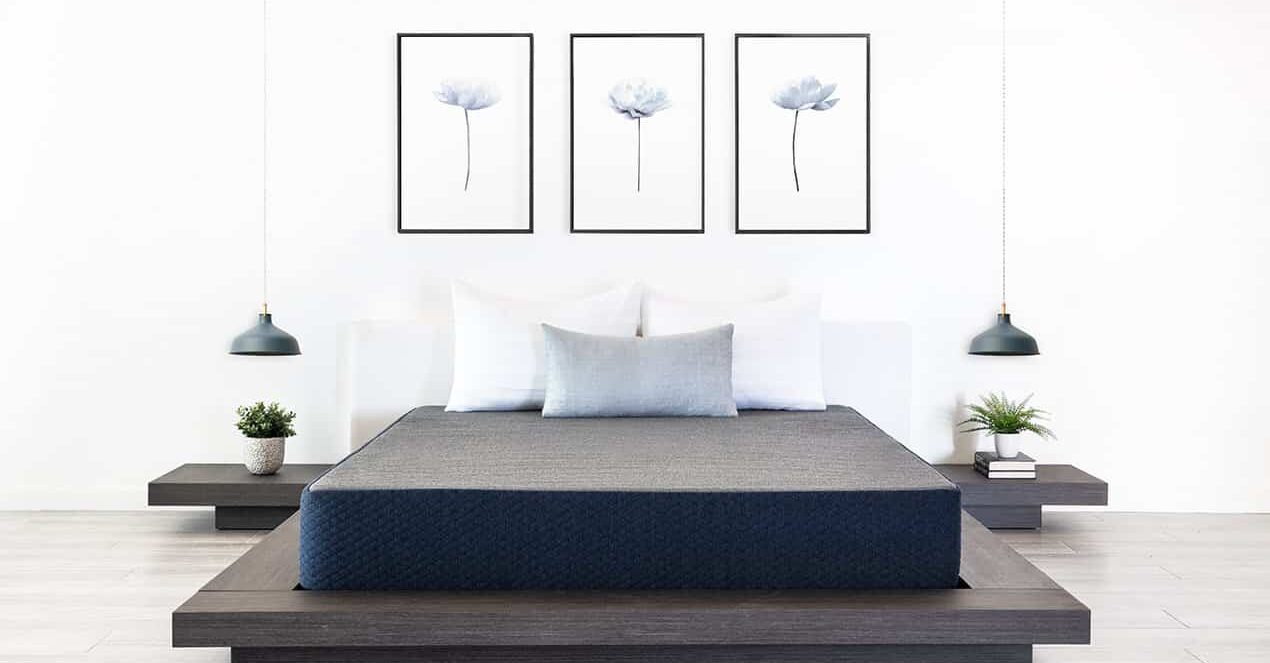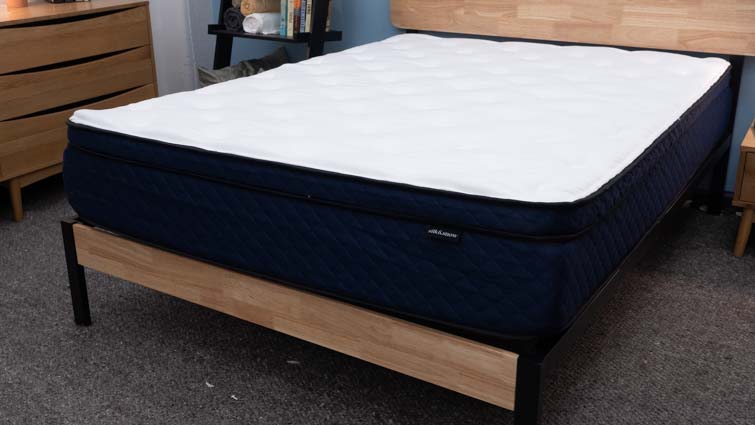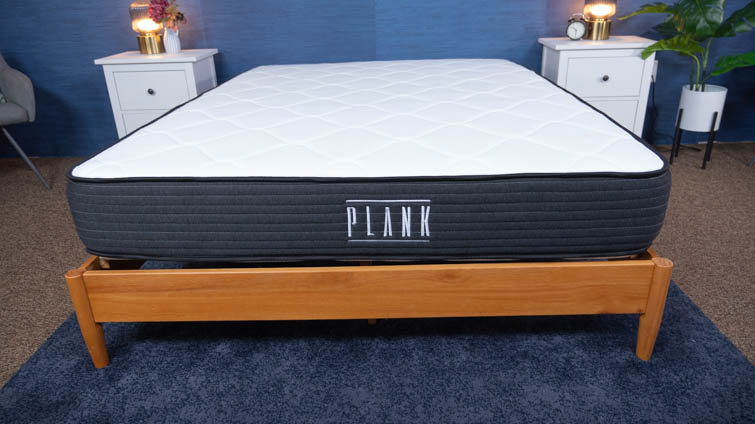If you’re on a budget seeking a high-quality online mattress, you may be wondering which options give you the best bang for your buck. In this article, I’ll be reviewing the PolySierra mattress, an all-foam bed offered at an affordable price. I’ll cover the materials, construction, feel, and performance across multiple tests. We’ll also go over pricing, company policies, and a brief comparison against other similar mattresses.
I’m a certified sleep science coach and mattress tester, so I know a thing or two about the best mattresses for different types of sleepers. Our team of expert testers has tested more than 330 mattresses in our Sleepopolis studio based in Charlotte, NC, using our medically approved testing methodology. We’ve seen our fair share of excellent and poor results, so we’re able to make very specific recommendations to sleepers based on their sleeping position, body type, and other sleep preferences.
Our team works with a network of medical professionals, such as board-certified doctors, registered nurses, physical therapists, and sleep experts, who review our findings for accuracy. Our chief medical advisor Dr. Raj Dasgupta, MD, FACP, FCCP, FAASM, worked closely with our team to create our testing methodology and also advised us based on his years of experience.
When we tested the Polysleep Sierra, it stood out due to its simple construction that still offers a balance between comfortable cushioning and spinal support. We were also impressed with its removable antimicrobial cover, which allows for easy cleaning. Based on its performance during testing, this bed is most compatible with lightweight and average-weight back sleepers.
The Polysleep Sierra is a simple all-foam bed with two layers, but it’s a good bet for budget shoppers—especially if they prefer to sleep on their backs. It’s more responsive and cooling than your average foam mattress, and it feels just a smidge softer than medium-firm for some nice cushioning. However, we don’t recommend it for couples or heavyweight folks.
What our tester says:
“I felt comfortable lying on my back toward the center of the mattress … I didn’t feel like I was sinking too much around my hips or my shoulders. Again, I think folks who are on the lighter side will fare better on this bed because it should feel closer to medium-firm for them, which is ideal for back sleepers.” – Kenny Timper, staff writer and certified sleep science coach
Polysleep Sierra Mattress Overview
The Polysleep Sierra is a 9-inch all-foam mattress made in Canada. When it comes to firmness, this bed has a balanced, medium feel that leans just a smidge softer than average. When lying on my back, the bed offered a combination of firm support that placed my spine in a neutral position and soft cushioning that filled in the space at my lower back.
As a bed-in-a-box mattress, the Polysleep Sierra arrives compressed at your door, ready to be unboxed and inflated. Since the bed doesn’t contain heavy spring coils, it’s super lightweight and easy to move around. While I usually recommend grabbing an extra set of hands to help you unbox, I think one person will be able to get the job done solo. There was a slight chemical factory smell released as the mattress was rising; however, this off-gassing scent dissipated within 24 hours.
When running the Sierra through our testing methodology, it scored highest in the responsiveness and cooling categories, earning 4 out of 5 stars for each. It scored lowest on our motion isolation tests, earning an average of 3 stars. When we tally up all the scores, the Polysleep Sierra mattress earns an average of 4 out of 5 stars.
Polysleep Sierra Mattress Sleepopolis Scores
Polysleep Sierra Mattress Comparison
- Brooklyn Bedding CopperFlex Memory Foam – Cooling construction
- Polysleep Luna – Similar softness
- Polysleep Origin Mattress – Firmer foam
- Dreamfoam Essential Memory Foam Mattress – Different height options
| Rating |
|
|
|
|
|
|---|---|---|---|---|---|
| Firmness |
Medium-soft: 6/10
|
Firm: 7.5/10
|
Medium-soft: 6/10
|
|
Firm: 7.5/10
|
| Material |
Foam
|
Foam
|
Foam
|
Foam
|
Foam
|
| Cooling |
—
|
|
—
|
—
|
—
|
| Best For |
Back Sleepers,
Stomach Sleepers |
Back Sleepers,
Stomach Sleepers, Hot Sleepers |
Side Sleepers,
Back Sleepers |
Side Sleepers,
Back Sleepers |
Side Sleepers,
Back Sleepers |
|
|
|
|
|
Polysleep Sierra Value
When we talk about value, we simply mean whether or not the bed is priced fairly considering the quality of its materials and overall mattress performance. The Polysleep Sierra has a very simple construction — just two layers of foam. At 9 inches tall, it’s not the tallest bed out there, which affected its performance in edge support and motion isolation. (If the bed were taller, the sinkage near the edges wouldn’t be quite as obvious. The short stature also means there’s less foam to absorb motion.) But as far as materials go, I’m impressed with the CertiPUR-US certification, which ensures the materials don’t contain heavy metals or other harmful chemicals. The mattress is also Antimicrobial Certified, meaning it’s been tested for effectiveness in reducing or eliminating bacteria, which isn’t something you often see.
When it comes to price, the Polysleep Sierra is very affordable. With a queen mattress costing just $690, this bed is one of the cheaper online mattresses I’ve tested. Although it’s a great budget buy, the materials don’t feel cheap, and the bed still offers strong support. Although the Sierra didn’t excel on every one of our performance tests, it’s still a solid mattress that gets the job done. The brand offers a 5-year warranty on this model, which isn’t impressive as far as mattress warranties go. However, I think this bed will last anywhere from 5 to 10 years based on our testing data and the bed’s materials.
Polysleep Sierra Comparison
- Brooklyn Bedding CopperFlex Memory Foam – Firmer all-foam mattress
- Silk & Snow Hybrid Mattress – Affordable hybrid mattress
- Brooklyn Bedding Plank Firm Mattress – Best for back pain
| Rating |
|
|
|
|
|---|---|---|---|---|
| Firmness |
Medium-soft: 6/10
|
Firm: 7.5/10
|
Medium-firm: 6.5/10
|
Multiple firmness options
|
| Material |
Foam
|
Foam
|
Hybrid
|
Foam
|
| Cooling |
—
|
|
|
—
|
| Best For |
Back Sleepers,
Stomach Sleepers |
Back Sleepers,
Stomach Sleepers, Hot Sleepers |
Side Sleepers,
Back Sleepers, Hot Sleepers |
Back Sleepers, Stomach Sleepers, Back Pain, Seniors
|
|
|
|
What Is the Polysleep Sierra Made Of?
When I test mattresses, I always cut into the side so I can get up close and personal with the materials and construction. This allows me to examine each layer individually and assess its quality.
When I cut into the 9-inch Polysleep Sierra, I found two layers of memory foam surrounded by a soft, machine-washable cover. The foams inside this bed have obtained a CertiPUR-US certification, which means they’ve been third-party tested against harmful chemicals, heavy metals, and ozone depleters. Additionally, the bed is Antimicrobial Certified, which can appeal to anyone who struggles with allergies.
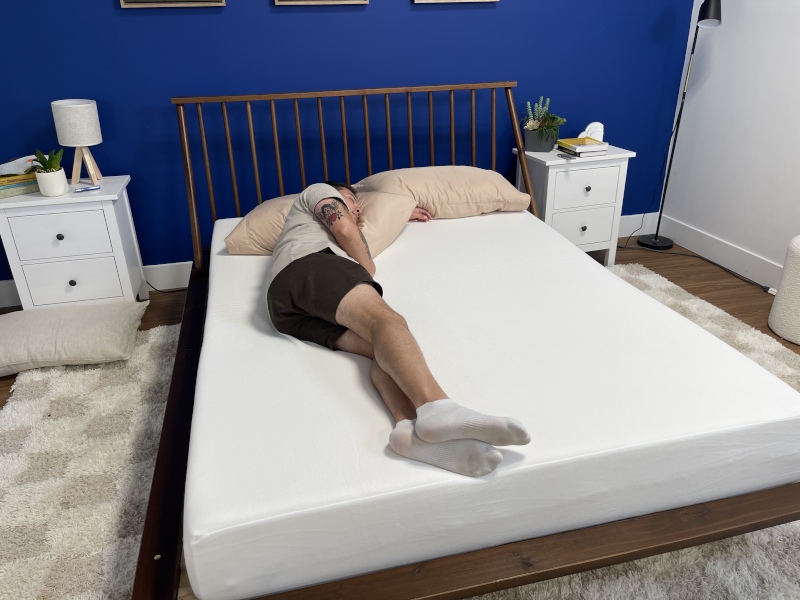
Cover – A thin cover that feels soft and smooth. The cover acts like a mattress protector and zips onto the mattress. If it gets dirty, it can be removed and washed.
Comfort Layer – A layer of antimicrobial foam that’s soft and has a quick response to pressure.
Support Layer – A thick layer of high-density foam that acts as the primary support system.
Polysleep Sierra Mattress Firmness
When it comes to firmness and feel, we know that not every sleeper has the same opinion. What you may consider very firm might feel super soft to another sleeper with a different body type or sleeping position. That’s why we rank firmness on a scale from 1 to 10 where 1 is the softest and 10 is the firmest. A score of 6.5 out of 10 marks a true medium-firm feel. We always have multiple expert testers provide their own firmness rating, and then find the average to create our final firmness score.

When we tried the Polysleep Sierra, we rated it a 6 out of 10 on the firmness scale. This means it’s a medium-soft mattress that’s supportive yet allows for some plush contouring. The first foam layer is soft enough to allow the sleeper to slightly sink in, while the high-density support foam lifts their hips and prevents them from bottoming out.
We think this firmness level, combined with the simple two-layer construction, makes the Sierra a great choice for back sleepers. While the bed provides plenty of lift at the hips to keep the spine properly aligned in this position, there’s still enough cushioning to fill in the space at the lumbar region.
Polysleep Sierra Mattress Performance
While a mattress’s construction and firmness are important to consider, there are a few performance factors that you’ll want to take note of before finalizing your purchase. I tested the Polysleep Sierra in our Sleepopolis testing studio with help from my colleagues Kenny Timper and Erin Chiles to evaluate its performance in pressure relief, motion isolation, responsiveness, cooling, and edge support.
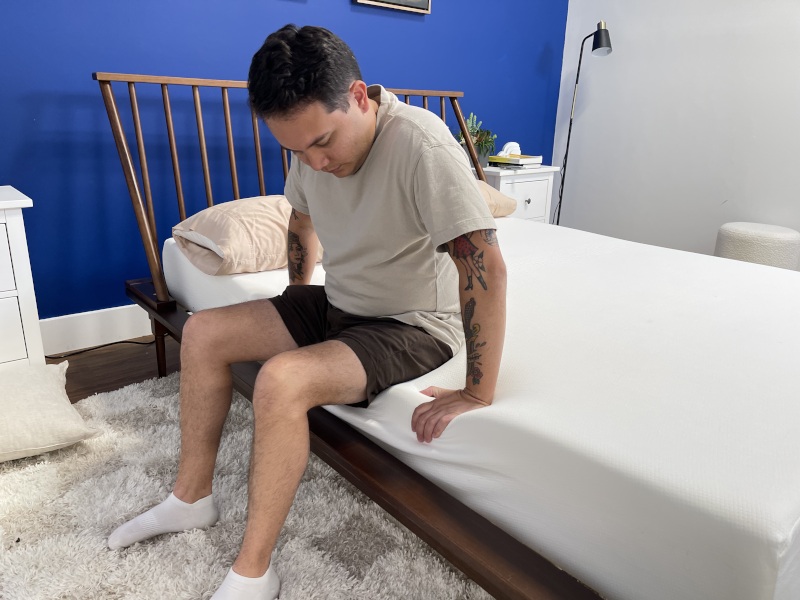
We collected data based on both subjective and objective tests to get a better understanding of how the mattress performs for different types of sleepers. Below, I’ll provide a quick summary of each test and how the Polysleep Sierra performed.
Polysleep Sierra Pressure Relief Performance
When it comes to pressure relief, Chief Medical Advisor Dr. Raj Dasgupta says memory foam is one of the best materials for contouring the body’s pressure points. Since the Polysleep Sierra is an all-foam mattress, I had high expectations for its performance on this test.
To get a better understanding of how the bed relieves pressure for different body types, my co-tester Kenny and I performed this test independently. Since I weigh less than 130 pounds, I fall in the lightweight sleeper category. This means I typically experience mattresses as firmer than average because I don’t sink as far into the bed’s layers. Kenny weighs between 130 and 230 pounds, which places him in the average-weight sleeper category. He typically finds more sinkage than I do and usually perceives mattresses as softer.
We evaluated pressure relief by lying on the mattress in both the back- and side-sleeping positions for several minutes. As we lay in each position, we paid attention to where on our bodies we felt pressure building and where we felt relief. We gave the Polysleep Sierra 4 out of 5 stars for pressure relief when back sleeping, and 3.5 stars out of 5 stars when side sleeping. When we averaged these scores together, we got an overall pressure relief score of 3.8 stars.
When I lay on the Sierra in the back-sleeping position, I really liked the way the comfort layer felt across my entire body. While there was some sinkage at my hips, I still felt comfortable and didn’t experience any pressure building at my lower back. In fact, I felt some nice cushioning at my lower back. Kenny agreed, saying, “I could feel my hips sinking in a little bit more than the rest of my body, but it wasn’t enough to feel uncomfortable or throw my spine out of a neutral, aligned position.” While he and I felt supported on this mattress, we think heavy back sleepers who weigh more than 230 pounds will sink too far into this bed, so they should seek a firmer mattress with a stronger support layer. Overall, we gave the Sierra an average of 4 stars for pressure relief when back sleeping.
In the side-sleeping position, I experienced more pressure starting to build at my hips and shoulders. Although the top layer is soft, my hips and shoulders sank right through it and landed on the high-density foam base. While my spine felt mostly aligned, I could feel some tension at my lower back. Kenny found a bit more sinkage in this position than I did, so he was able to get more cushioning at his joints. Overall, we gave this mattress 3.5 stars for the side-sleeping pressure relief.
Polysleep Sierra Motion Isolation
If you sleep with another person, this section may be especially relevant. Motion isolation refers to the bed’s ability to absorb movement on impact and prevent the sleeper on the other side of the bed from feeling it. When a bed has low motion transfer, both sleepers can toss and turn as much as they want without disturbing their partner. Dr. Raj Dasgupta says motion isolation can also be an indicator of the materials and construction quality. We assessed motion isolation using a ripple test and a partner test, and the Poly Sleep Sierra earned an average score of 3 out of 5 stars.
We began the ripple test by placing a large tub of water on one side of the mattress and then rolling around and switching sleeping positions on the other side. We observed how much our movement impacted the liquid and whether it had just a few ripples or major sloshing. When Kenny performed this test, he noticed the water was aggressively stirring inside the container as he rolled around. “Normally, an all-foam mattress would do a better job of muffling motion, but because the Sierra is so thin, the layers just aren’t able to absorb as much of the impact,” he said. He ended up giving the mattress 3 stars for the ripple test.
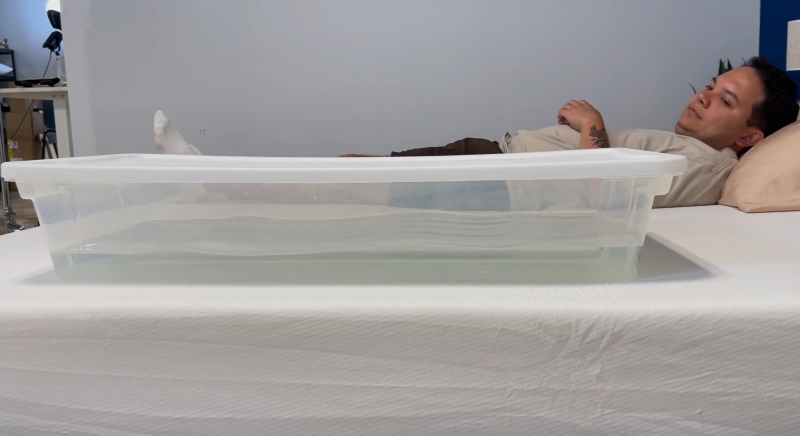
The next test was our partner test. This is similar to the ripple test, but we used a human instead of a water tub. Kenny lay on the bed with a blindfold on while I climbed in next to him and switched between sleeping positions. If he could feel my motion, he raised his hand. While the bed slightly reduced the motion transfer, Kenny could still tell what I was doing on the other side of the bed throughout most of the test, so the bed only earned 3 stars. “If you are a deep sleeper, then it shouldn’t be an issue,” he said. “But, if you or your partner is easily disturbed, I would recommend a thicker memory foam mattress.”
Based on the above tests, I would not recommend this mattress to sleepers who are easily awakened by a restless partner. While some sleepers may be able to sleep through their partner’s tossing and turning, light sleepers will likely experience disrupted sleep.
Polysleep Sierra Responsiveness
When we talk about responsiveness, we simply mean how quickly the bed returns to its original shape after pressure has been applied. In our experience, all-foam mattresses like this one are the least responsive because they don’t contain bouncy spring coils. We performed three objective tests and one subjective test, which earned the Polysleep Sierra 4 stars for responsiveness.
Switch test: This test is very simple. A tester lies on the mattress and moves from their back to their side to their stomach. They observe how easy it is to transition between the sleeping positions and if they experience any bounce while doing so. They also observe whether they feel any layers trapping them and inhibiting their movement. I performed this test myself and found the Sierra pretty easy to move around on. Since it’s on the softer side, my mobility was slightly inhibited by the top layer of foam. However, the firmer base layer prevented me from feeling stuck in the bed. I was still able to move around, albeit with a small amount of effort, so I gave the bed 4 stars for the switch test.
Responsiveness test: Our tester Erin Chiles performed this test, which involved placing a 53-pound kettlebell on the bed for seven seconds and then pulling it straight up. She used a stopwatch to measure exactly how long it took for the Polysleep Sierra to return to its original shape, which was 0.6 seconds. This isn’t the quickest rebound but is still fairly responsive, so this test earned the bed 4 stars.
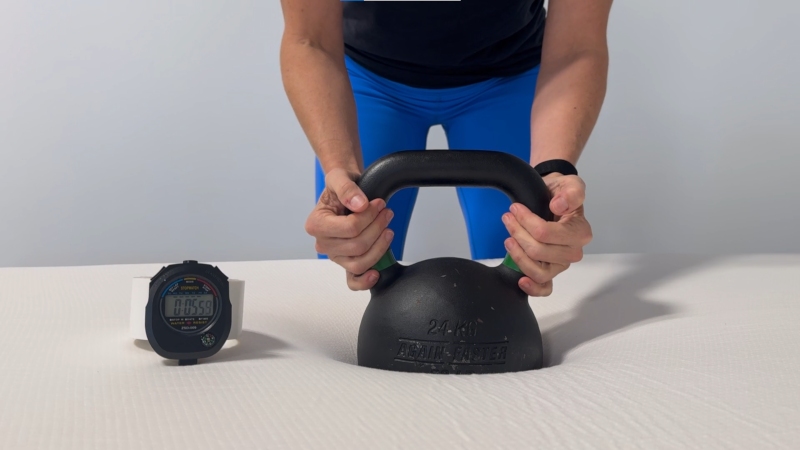
Sinkage test: For this test, Erin got the kettlebell back out and placed it at the center of the mattress. She used a ruler to measure how far it sank in and found a depth of 3.3 inches. This level of sinkage places the Polysleep Sierra in the “moderate sinkage” category. While you won’t experience intense body contouring, you’ll still feel a decent amount of cushioning from this mattress.
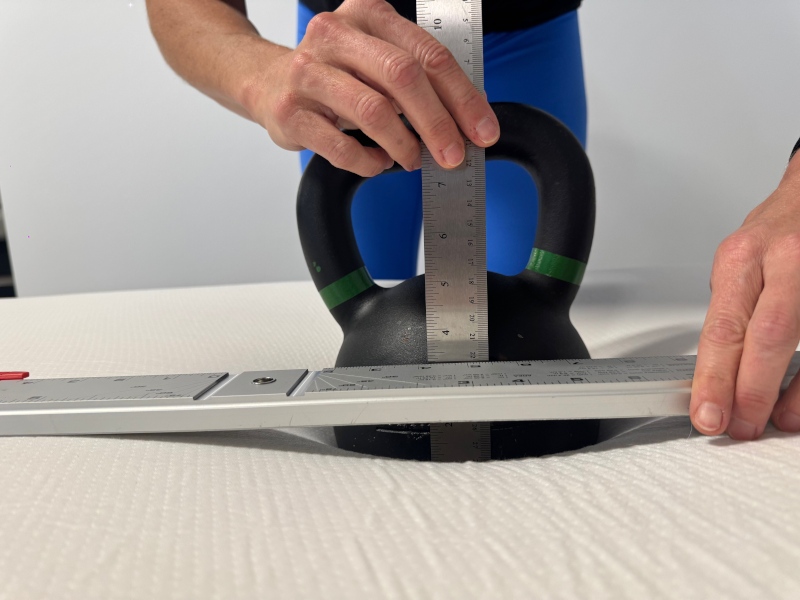
Bounce test: Finally, we dropped a 25-pound steel ball from 6 feet high onto the mattress and used a yardstick on the wall to measure how high it bounced. The ball rebounded 21.5 inches into the air, classifying the bed as “high bounce.” Since it’s a shorter all-foam bed, I was surprised that it offered so much buoyancy.
Polysleep Sierra Cooling
If you’re a hot sleeper who often overheats at night, you may want to pay attention to this section. If your bed doesn’t help regulate temperature, prevent heat trapping, and wick away moisture, you could wake up a sweaty mess. We evaluated the Polysleep Sierra’s cooling abilities using a thermal gun test, a cover test, and a feel test to create an overall cooling score of 4 out of 5 stars.
Thermal gun test: This test collects quantitative data that shows how the mattress responds to body heat. We first grab our thermal gun and record the initial temperature of the mattress before anyone has touched it. Then, we have a tester lie on it for five minutes, and record the bed’s temperature again. If the temperature increases by fewer than 5 degrees, we consider it to have excellent cooling. An increase of 5 to 10 degrees indicates good cooling, 10 to 15 degrees indicates decent cooling, and more than 15 degrees indicates poor cooling.
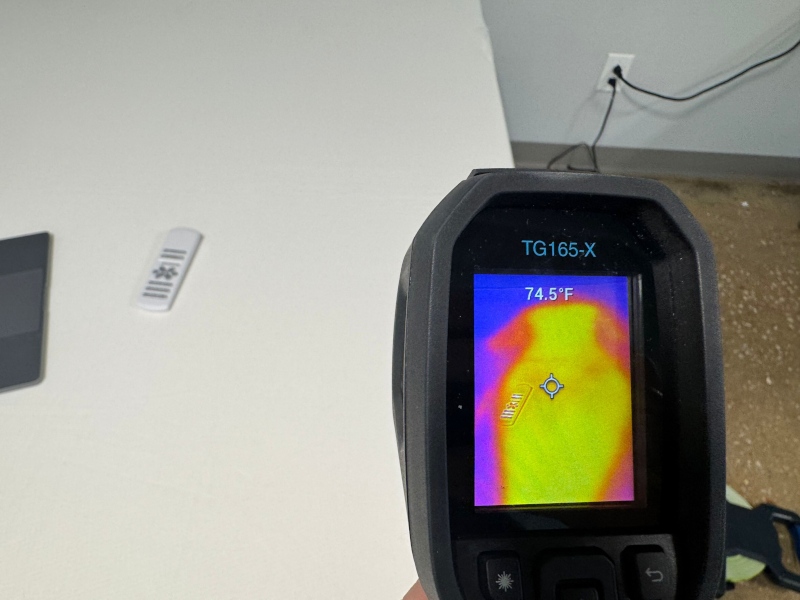
When Erin performed this test on the Polysleep Sierra, the mattress’s temperature went from 67.5 degrees to 74.3 degrees. This is a 6.8-degree temperature increase, which earned the bed 4 stars for the thermal gun test and indicates good cooling abilities.
Cover test: Before beginning the thermal gun test, Erin felt the Sierra’s cover and whether it felt noticeably cold. While she didn’t find it cool to the touch, she thought it was more temperature-neutral than actually warm.
Feel test: Next, the tester observes whether or not they can feel the mattress heating up below them. Erin said, “I didn’t notice my body heat being retained, and I didn’t feel like I was overheating.” Although the bed doesn’t contain innerspring coils, which promote breathability and airflow, the mattress did a decent job regulating temperature.
If you occasionally sleep hot, this mattress could be a good choice. While it doesn’t provide an initial cool-to-the-touch feel, it remains room temperature and prevents body heat from becoming trapped. If you consistently experience night sweats and overheating, you may need a bed with more cooling technology.
Polysleep Sierra Edge Support
When a mattress has strong edges, the perimeter of the bed is just as supportive as the very center. This can be important for couples, as it allows them to use the full surface area of the mattress and spread out without feeling like they’re about to fall off. It’s also a durability indicator, as weak edges are more likely to sag over time. When we tested edge support on the Polysleep Sierra, we performed a tape measure test, a seated test, and a full body test to create an overall score of 3.4 stars.
Tape measure test: This objective test involved placing stacks of weighted plates directly on the edge of the bed and measuring how many inches the layers collapsed. We created three stacks to represent three weight classes— a 99-pound stack, a 154-pound stack, and a 198-pound stack. From lightest to heaviest, the sinkage went from 1.5 inches to 2.5 inches to 2.5 inches. When we combined the ratings from each stack, the Sierra earned an average of 4.7 stars for the tape measure test.
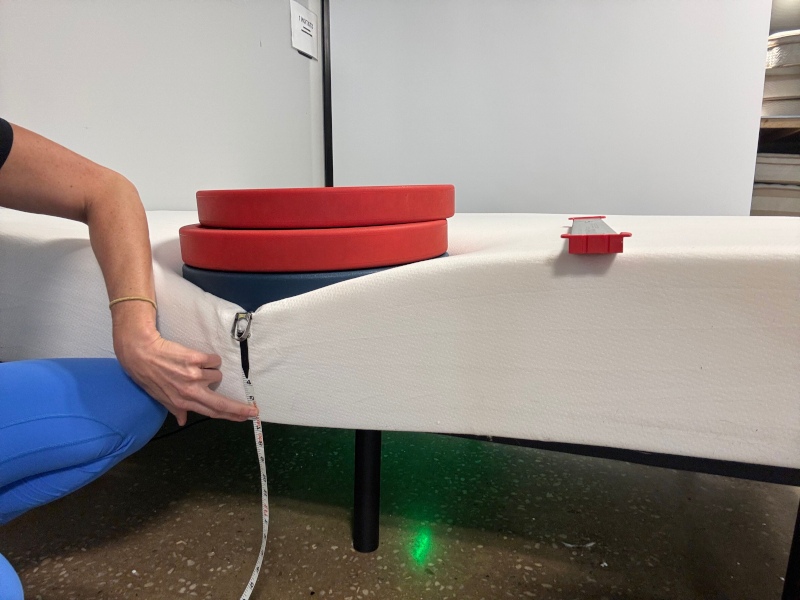
Seated test: Next, a tester sat on the edge of the bed with their feet on the floor and stood up and down. They paid attention to how supported they felt and whether they needed to use their hands to assist them when standing. When Kenny performed this test, he was not impressed. He said, “Since it’s so thin and soft, you bottom out immediately after sitting on the perimeter.” Since he didn’t feel lifted and supported in this position, he gave the Sierra’s seated edge support only 1 star.
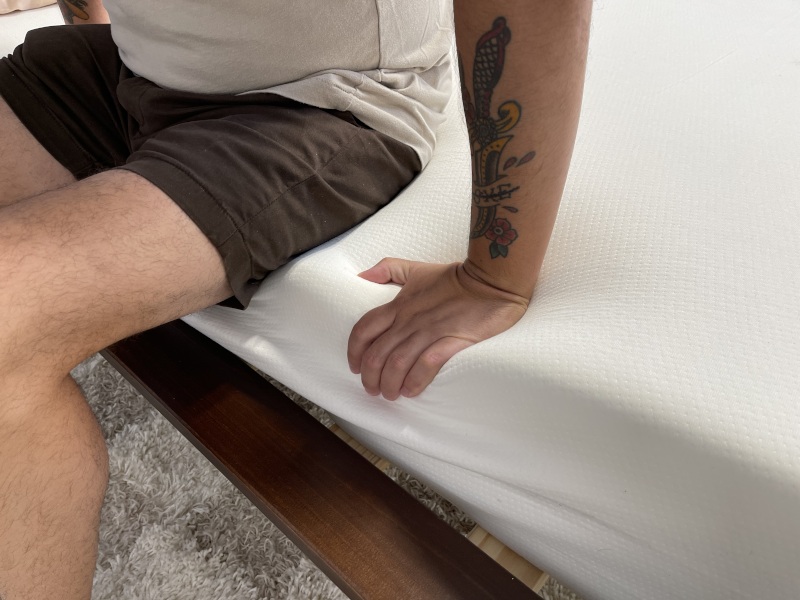
Full body test: Finally, our tester lay on their side, back, and stomach directly on the edge of the bed and observed their stability. Kenny felt slightly more supported in this position but still didn’t think the edges were as supportive as the center of the mattress. “I didn’t fall off, but I wouldn’t say I felt stable,” he said. “On my side and back particularly, I felt the sensation of sliding off the mattress, like I was lying on a slope.” Since he still didn’t feel completely secure, he rated the lying-down edge support 2 stars.
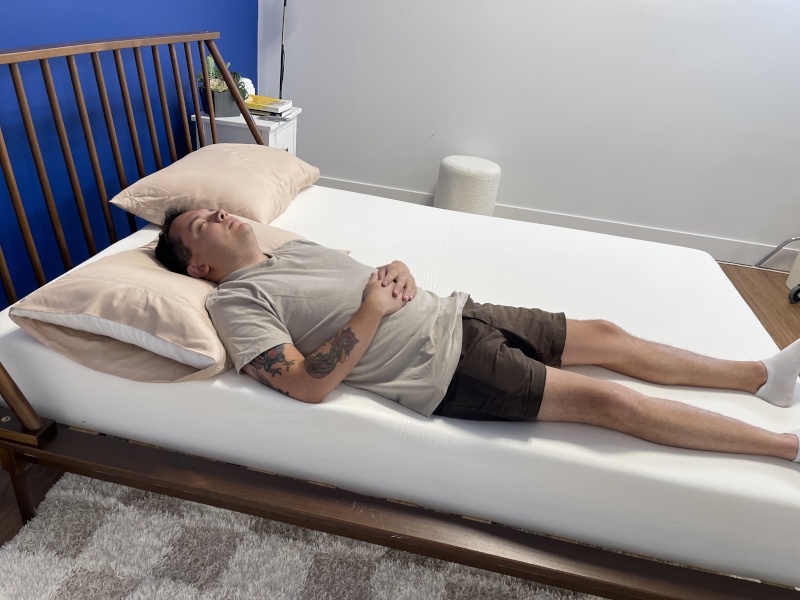
Although the Sierra performed well during our weighted edge support test, Kenny’s subjective testing experience indicated that sleepers may not feel comfortable sleeping close to the edge. We noticed a clear difference in support between the edge and side of the mattress, and it wasn’t easy to sit on the edge without sliding off. People with mobility issues will likely need a mattress with better edge support, on which they can safely bear down when getting in and out of bed.
Polysleep Sierra Mattress Performance for Couples
If you sleep with a partner, cooling, responsiveness, motion isolation, and edge support are the most relevant factors. Based on the Polysleep Sierra’s performance in these categories, it may not be the best mattress for couples.
Motion isolation is one of the most important elements for couples to pay attention to, especially if one or both partners toss and turn or frequently get out of bed. Since the Sierra only earned 3 stars in this category, you’re likely to feel your partner’s motion, which could disturb your sleep. Likewise, strong edges allow couples to fully spread out and use the entire surface of the mattress. Since we only gave the Sierra 3.4 stars for edge support, couples may find themselves crowding the center of the bed for support.
The Sierra performed better on our cooling and responsiveness tests, earning 4 stars for both categories. Since two people heat up quicker than just one, it’s important for couples to find a bed with good cooling abilities. While most couples shouldn’t overheat on the Sierra, two hot sleepers may find the “temperature-neutral” feel still too warm. Responsiveness can also be crucial for sexually active couples, as it allows them to easily move around on the bed. Couples should be able to easily switch between positions without feeling trapped in the mattress.
Other Performance Factors to Consider
While the tests above are the most important to a majority of sleepers, there are a few additional tests we perform to give you the full scope of the bed’s abilities.
Sex
We create our score for sex by finding the average of the responsiveness, cooling, and edge support tests. The best mattress for sex is usually responsive enough for couples to easily move around and switch positions. It also helps keep things from getting too steamy by providing good cooling and has strong edges that can be relied on no matter where your activity takes you on the bed. With 4-star responsiveness, 4-star cooling, and 3.4-star edge support, the Sierra earned an average score of 3.8 stars for sex. While you should have no trouble having sex on this mattress, your wildest activities may be limited to just the center of the bed.
Noise
Erin Chiles tested the noise on this bed by rolling around, jumping up and down, and pressing on the bed. She found it completely silent and didn’t notice the sound of air escaping the foam when she pressed down on it. She rated this bed 5 stars for noise because it shouldn’t disrupt your sleep, even when you move around.
Base Compatibility
Erin also tested the Polysleep Sierra’s base compatibility by pairing it with an adjustable base in our studio. She elevated the head and legs at various angles and placed it in the zero-gravity preset, which simulates a weightless feeling. She gave the compatibility 5 stars because it bent with ease and perfectly conformed to the base. “I think the height of only 9 inches, as well as the memory foam construction, helped the bed conform really nicely to the base,” she said. In addition to adjustable bases, this mattress is also compatible with box springs, platform beds, and slatted bases.
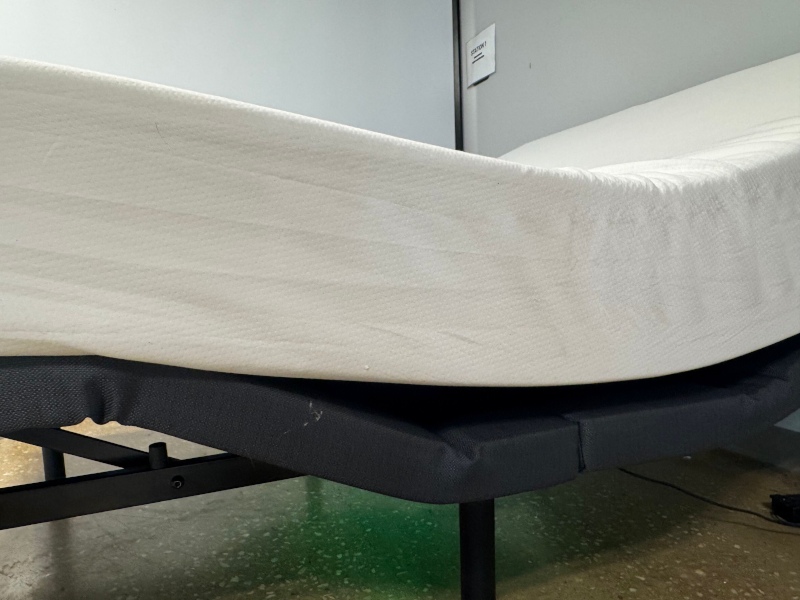
Durability
A mattress is a major purchase, so you’ll want to use it for a long time without needing to replace it too soon. We evaluate durability by looking at the quality of the materials, the support layer, the support at the edges, and the mattress warranty. High-quality materials last longer than cheap materials and are less likely to deteriorate over time. A strong support system, especially at the edges, prevents the bed from sagging prematurely and causing uncomfortable indents. The warranty can also give us an idea of how long the company expects its product to last.
Overall, we thought the materials were of good quality, especially considering they earned a third-party certification for safety. While the bed provides decent support, its edges aren’t very secure, earning 3.4 stars during testing. For all-foam mattresses like this one, strong support is crucial to preventing sagging and indentations. I could see this bed holding up for about 5 years, which is coincidentally how long the limited warranty lasts, and I also predict sagging along the edges as the years go by.
Polysleep Sierra Performance Scores
| Test | Product Score | Average Score |
| Firmness | 6 | 6.7 |
| Pressure Relief Side | 3.5 | 3.5 |
| Back Pressure Relief | 4 | 4 |
| Motion Isolation | 3 | 4 |
| Responsiveness | 4 | 4.3 |
| Cooling | 4 | 4.1 |
| Edge Support | 3.4 | 4 |
| Bounce Height | 21.5 | 16.3 inches |
| Bounce Rating | High | Moderate |
| Sinkage | Moderate | Moderate |
| Sex Score | 3.8 | N/A |
| Noise | 5 | 4.5 |
| Off-Gassing | 3 | N/A |
| Trial Period | 3.5 | 4.3 |
| Warranty | 3 | 4.6 |
| Full Rise | 5 | N/A |
| Unboxing/Moving | 5 | 3.5 |
Polysleep Sierra Sleeping Position and Body Weight
Your sleeping position and body type are directly correlated to how the mattress will perform for you. For example, what feels soft to a heavy stomach sleeper will likely feel very firm to a lightweight side sleeper. It all depends on how much weight is being placed on certain parts of the body. Below, I’ve broken down each weight class and how the bed will likely perform on your back, side, and stomach.
Before we dive into our recommendations, though, we want to recognize that people come in all shapes and sizes, and people of every size deserve a mattress that works for their body type. We use the weight categories light, average, and heavy to more easily categorize sleepers based on how mattresses will perform for their body type, as most mattresses are designed for the group we call “average” (130 to 230 pounds).
As a general takeaway, lighter sleepers don’t require as much support as average-weight sleepers, and mattresses will tend to feel firmer to them. On the other hand, heavy sleepers tend to need more support than average-weight sleepers and sink into the mattress more. As far as sleeping positions go, side sleepers often need a softer mattress while stomach sleepers usually need a firmer, more supportive one. Back sleepers are usually somewhere in the middle.
Is the Polysleep Sierra a Good Mattress for Light Sleepers (Under 130 pounds)?
- Light Back Sleepers – These sleepers will experience a small amount of sinkage at the hips while still getting enough lift to prop the spine in a straight line.
- Light Side Sleepers – These sleepers will sink through the top layer, but won’t find enough sinkage overall to prevent pressure from building at their hips and shoulders.
- Light Stomach Sleepers – The bed is soft, yet it provides enough lift to keep these sleepers’ hips in line with their shoulders and prevent lower back pain.
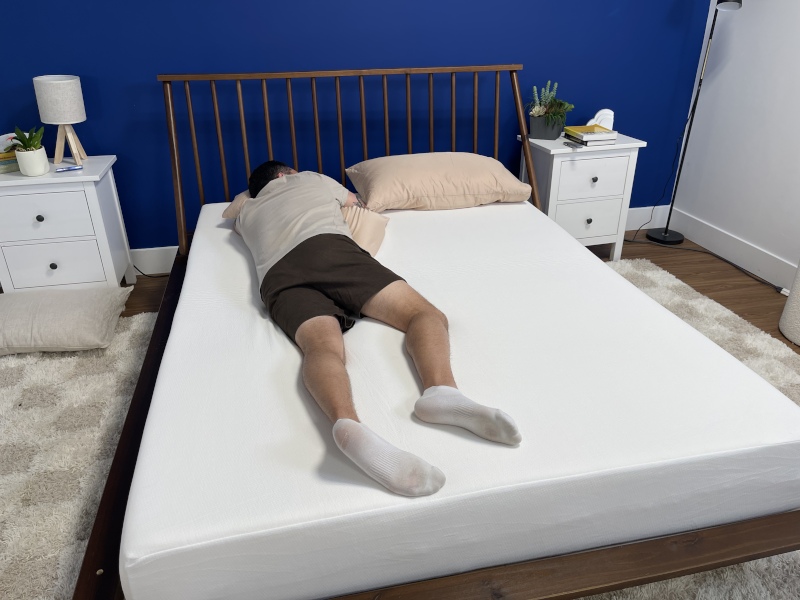
Is the Polysleep Sierra a Good Mattress for Average-Weight Sleepers (130–230 pounds)?
- Average-Weight Back Sleepers – This position should feel great for these sleepers, as they’ll get a balance between spinal support and cushioning at the lumbar region.
- Average-Weight Side Sleepers – These sleepers should find more sinkage into the base layer, which allows them to experience more pressure relief at the joints. However, people with preexisting hip or shoulder pain may need a bed with deeper sinkage and contouring.
- Average-Weight Stomach Sleepers – The bed is likely too soft to lift these sleepers’ hips in line with their shoulders. Their lower back may start to bend out of alignment, which can lead to pain over time.
Is the Polysleep Sierra a Good Mattress for Heavy Sleepers (over 230 pounds)?
- Heavy Back Sleepers – We don’t recommend the Polysleep Sierra to heavy sleepers in any sleeping position. We’d steer them towards an ultra-supportive bed, such as one of the options on our best mattresses for heavy people roundup.
- Heavy Side Sleepers – See above.
- Heavy Stomach Sleepers – See above.
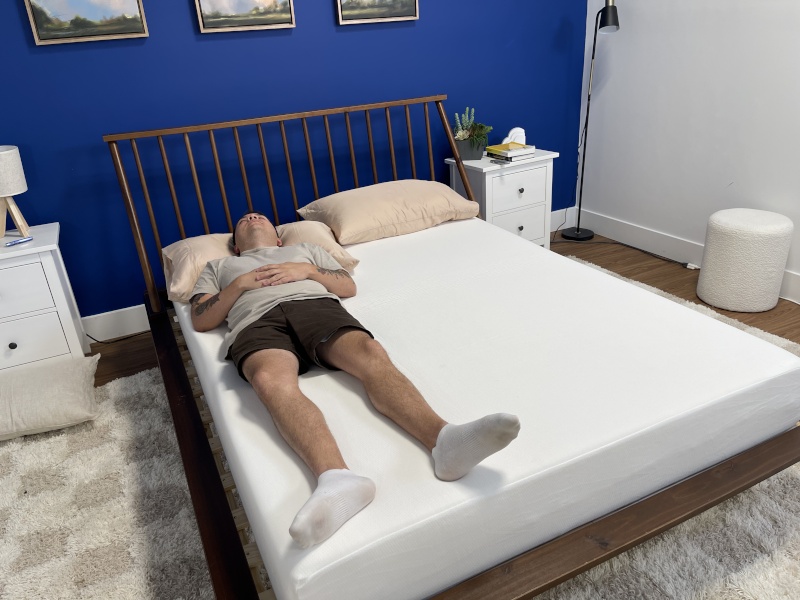
My Final Thoughts About the Polysleep Sierra Mattress
Let’s quickly recap my favorite things about the Polysleep Sierra, as well as some areas it fell short.
Who I Recommend the Polysleep Sierra For
- Budget shoppers can find this mattress at an affordable pricepoint and will likely find it on sale.
- The soft cushioning and sturdy support layer makes the Sierra perfect for back sleepers.
- Combination sleepers should be able to switch between sleeping positions without exerting too much effort.
- The mattress is a great match for an adjustable base.
Who I Don’t Recommend the Polysleep Sierra For
- Couples may not like this bed due to its subpar motion isolation, which can lead to sleep disruption.
- People with mobility issues, such as older adults, will likely need a mattress with stronger edge support to assist them in getting in and out of bed.
Polysleep Sierra Pricing and Sizing
Most shoppers take a look at the price before checking out, and this is especially important when making a major purchase like a mattress. Not only is the Polysleep a great budget buy, but it’s often on sale. Let’s break down how much this bed costs at full retail. Note, this mattress is not offered in twin XL or California king sizes.
| Size | Price |
| Twin | $580.00 |
| Full | $645.00 |
| Queen | $690.00 |
| King | $780.00 |
Polysleep Sierra Policies
It’s important to read the fine print when buying a new mattress to ensure you’re getting the best experience for your money. Let’s take a quick glance at Polysleep’s company policies.
| Warranty | 5-year warranty |
| Sleep Trial Period | 100-night trial |
| Shipping/Returns | Free shipping within the U.S and Canada. |
| Unboxing | The mattress arrives compressed in a box at your door. It’s super lightweight, so one person can unbox the mattress solo and set it on a bed frame. |
| Full-Rise | The mattress begins to inflate immediately after unboxing and is ready to sleep on within minutes. |
| Customer Reviews | This bed earned 4.7 stars on the Polysleep website based on 1,600+ customer reviews. |
Polysleep Sierra vs. Competitor
The Polysleep Sierra isn’t the only budget all-foam mattress on the market. Let’s compare it to another popular bed, the Brooklyn Bedding CopperFlex.
Polysleep Sierra vs Brooklyn Bedding CopperFlex Memory Foam
Like the Sierra, the Brooklyn Bedding CopperFlex is made entirely of foam. However, the CopperFlex has three times the layers, including a quilted foam cover, and is a full 3 inches taller. The CopperFlex is a solidly firm mattress, falling at a 7.5 out of 10 on the firmness scale. While the two mattresses performed similarly on our pressure relief and cooling tests, the CopperFlex earned higher scores in motion isolation and edge support.
- Price: These beds are both affordable options, priced similarly. The Polysleep Sierra costs $25 more than the CopperFlex for a queen-size bed. For a king size, the CopperFlex costs $147 more than the Sierra.
- Sleeping position: Both mattresses are best for back sleeping. The Sierra is the better choice for side sleepers, and the CopperFlex is ideal for stomach sleepers.
- Cooling: Both mattresses earned 4 out of 5 stars on our cooling test.
- Body weight: The CopperFlex offers more support, making it a better choice for heavy sleepers.
Read more in our full CopperFlex mattress review.
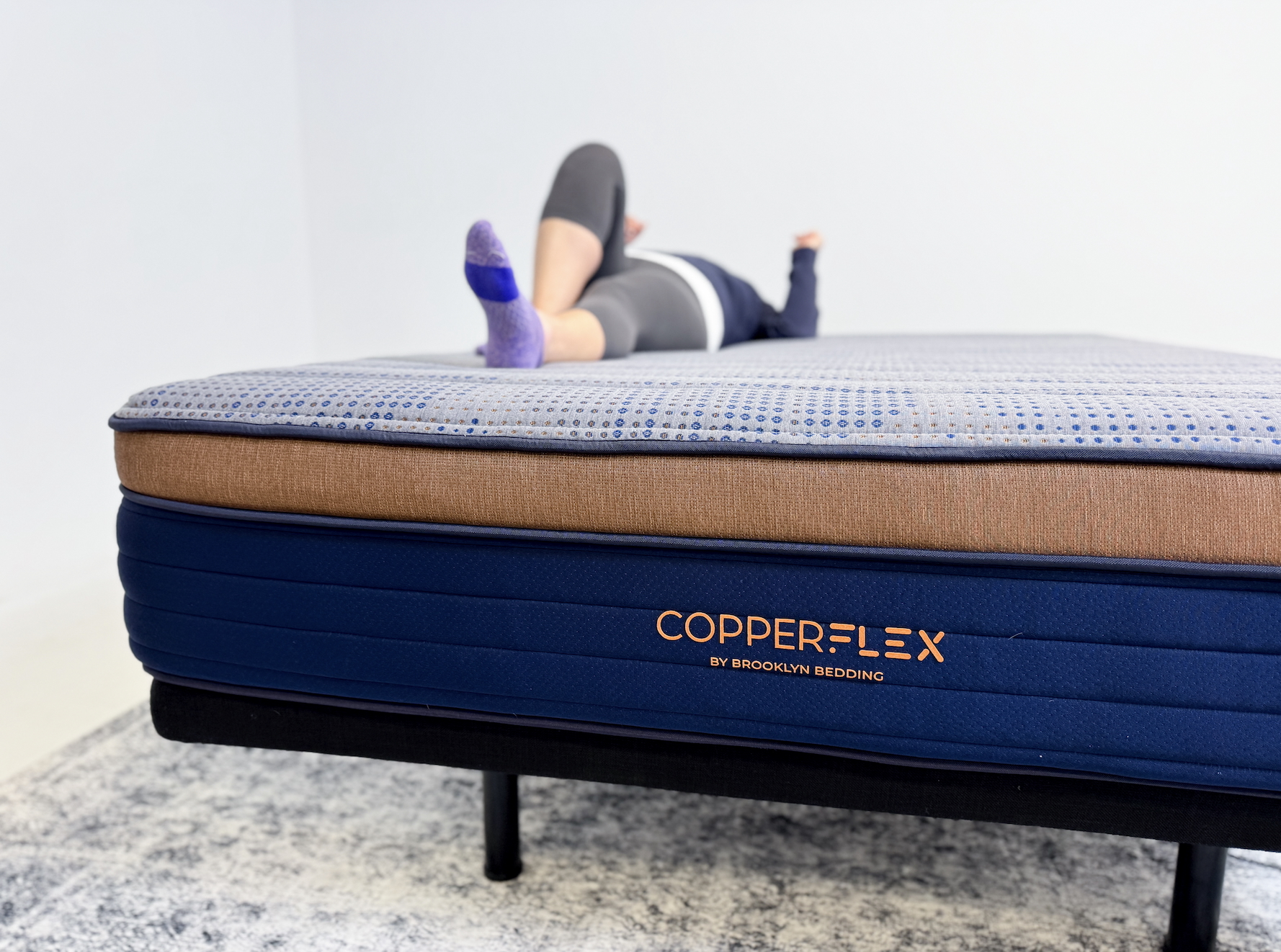
Brooklyn Bedding CopperFlex Memory Foam

Product Details
Our Recommendation
Financing Options
Financing options are available for this mattress.
Other Models from Polysleep
As a brand, Polysleep offers some other affordable Canadian mattresses in addition to the Sierra. Check out one of their most popular models below.
Polysleep Sierra vs Polysleep Luna
The Luna is another softer foam mattress from Polysleep (each model scored a 6 out of 10 on our mattress firmness scale), though the Luna has an extra transition and an overall construction that’s a little more complex.
- Price: While both beds are both fairly affordable, the Sierra costs much less.
- Sleeping position: Both models are best-suited for back sleeping. The Luna is the better fit for side sleeping and neither option is ideal for stomach sleeping.
- Cooling: The Sierra scored a solid 4 on cooling, while the Luna only scored a 2.5. If you’re a hot sleeper, we definitely recommend going with the Sierra.
- Body weight: We don’t recommend either mattress for sleepers over 230 pounds.
Read more in our full Polysleep Luna mattress review.
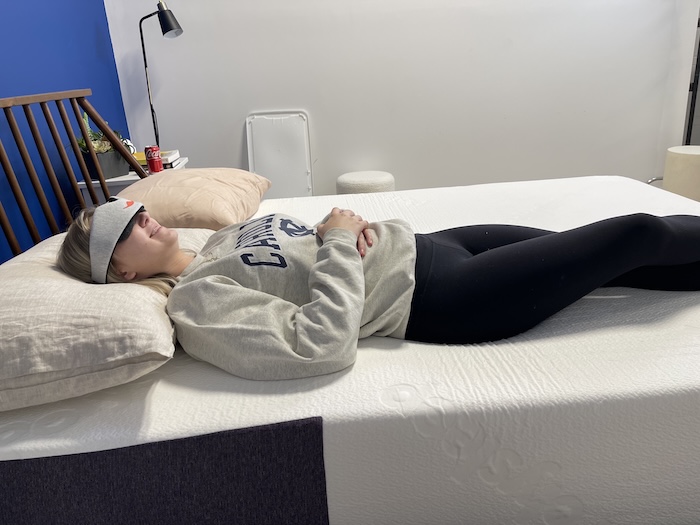
Polysleep Luna

Product Details
Our Recommendation
Our Review Process
At Sleepopolis, our team of certified sleep science coaches personally test each mattress. We start by unboxing the mattress to figure out how difficult (or easy) it is to get the mattress from the box to the bed. Then, we spend time lying on the bed in different positions, taking time to assess it on our backs, stomachs, and sides. Next, we perform our Sleepopolis tests, using specialized tools to measure qualities like motion transfer, bounce, and pressure relief. Our last step is to open up the mattress and take a look at each layer. These steps allow us to give our final verdict on the mattress.
FAQs
Does the Polysleep Sierra mattress come with a sleep trial period?
Yes, the Polysleep Sierra comes with a 100-night sleep trial.
Does the Polysleep Sierra mattress come with a warranty?
Yes, the Polysleep provides a 5-year warranty for the Sierra mattress.
Is the Polysleep Sierra made in the USA?
No, Polysleep mattresses are made in Montreal, Canada. However, shipping is still free within the United States.
Where can I try the Polysleep Sierra mattress?
You can use the store locator tool on the Polysleep website to find a location nearest to you. But note, the brand is primarily an online retailer and only carries the mattress in-store in Canada and select Northeast U.S. locations.
How firm is the Polysleep Sierra mattress?
We rated the Polysleep Sierra a 6 out of 10 on the mattress firmness scale, making it a medium-soft mattress.
